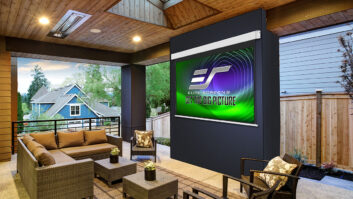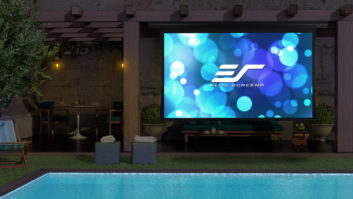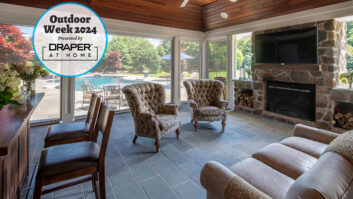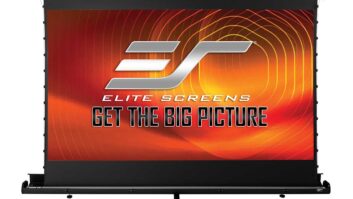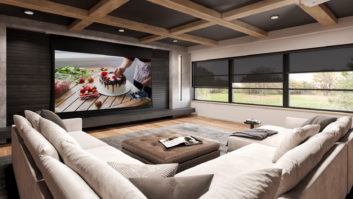Elite Screens Yard Master:
Kudos: Terrifically simple installation; tensioning creates a really flat surface; case-mounted controls
Concerns: Fixed mounting points might make mounting a challenge; low-gain doesn’t compete with ambient light
LG CineBeam PU700R:
Kudos: Cool style/form factor that invites a variety of uses; 4K video wherever you want it
Concerns: Auto adjustment is unreliable; sluggish response; audio quality; no Netflix
As technologies have improved, enjoying a big screen experience no longer means being hunkered down in a media room or dedicated theater. Now, with portable projectors with built-in streaming small enough to carry around, you can enjoy a cinema-sized image wherever you go.
And is there anything more decadent than having an outdoor movie theater with a 4K projector and motorized screen you can enjoy while lounging by the pool? This is an excess not even imagined by Caligula!
It’s been over three years since Elite Screens sent me its Yard Master outdoor screen, and while I enjoyed using it, it wasn’t perfect for my application. For one, raising/lowering the screen meant dragging out an extension cord to power it up. For another, that tensioned screen was only offered in the company’s WraithVeil material, which is bi-directional, accommodating both front and rear projection setups. However, in my setup with the screen hanging about a foot in front of a wall of my home painted a light beige color, all the light blasting through the screen really lights up the light-colored wall behind the screen, which reflects back onto the screen, knocking down contrast. Finally, the negative, 0.8 gain material didn’t really help with creating a bright image.
In my review I wrote, “For my install, I probably would have been better served by Elite Screen’s CineWhite front projection material, which offers 1.1 gain and is also outdoor-rated. However, they don’t currently offer that fabric option in the tensioned version.”
Well, three years on, Elite Screens now has a new Wireless Yard Master that uses the CineWhite material available in 125- and 140-inch diagonal (16×9), is also tensioned, and is powered by a built-in rechargeable Li-on battery!
Of course, what is a screen without a projector? To complete the review, LG sent its new CineBeam PU700R portable 4K LED projector with built-in streaming, and together these make for some potent outdoor entertaining.
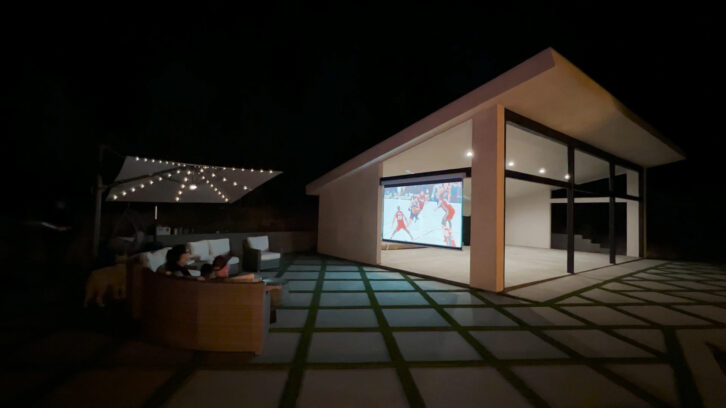
Elite Screens Yard Master Wireless
The screen arrives completely assembled, with a small bag of hardware for wall mounting using the keyhole slots on the sides. For ceiling mounting, there are mounting bolts/loops on the ends of the case. Unlike the previous model, these top mount points are fixed, so if you can’t hit a stud of something structural at those locations, you’ll either have to use blocking or get creative. For me, I measured the two end points, found where I wanted the screen center to be, and then drilled a couple of pilot holes in the framing in my soffit and used the eye-bolts and carabiners from my previous install. Throw a level on it, make any needed adjustments, and you’re done.
Visually, the screen is nice-looking, and the case is a bright clean white compared to the copper-brown color of the older model. This will either work for you or it won’t. Since my home’s trim is white, it looks better. How the white case will hold up over time is certainly a question, as I can tell you the previous screen weathered a bit after three years outside. When retracted, the screen goes further up into the housing than the previous model, which should help keep the material cleaner.
The steel case housing is rust-proof, and the screen material is mildew-resistant with an IPX3, meaning it resists “water spray less than 60 degrees from vertical.” Elite Screens advises it isn’t designed to be exposed to direct sunlight or rain and should be kept in the retracted position when not in use. And if anything gets on the screen, you are free to wipe it off using a soft cloth and mild soap and water.
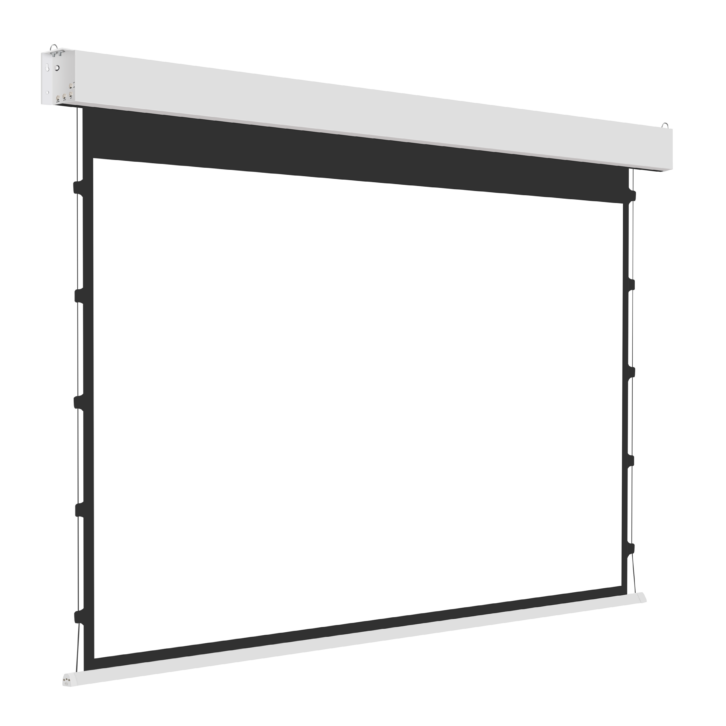
There is an included AC power pack for charging the internal Li-on battery, and this plugs into a port behind a sealed rubber stopper on the left side of the screen. Elite says the charge will last up to three months and is good for up to 200 up/down cycles. When the charge remaining is below 10 percent, the screen will beep when it is being used.
Next to the charging port you’ll find buttons for Up/Down/Stop. Kudos to Elite for including these buttons as a backup in case you lose the RF remote!
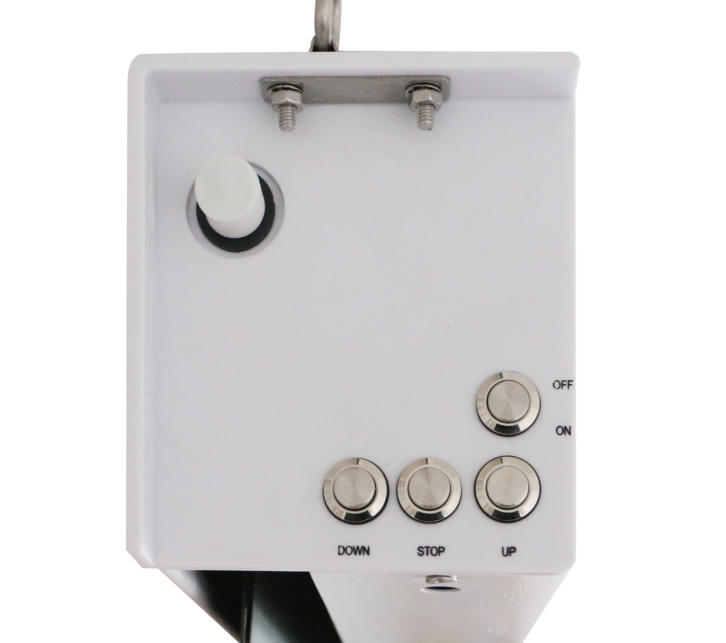
When fully lowered, there are 12 inches of black drop at the top, along with some black masking around the sides and bottom, helping with overscan and perceived contrast. The screen also has black backing to eliminate light penetration, my big problem with the previous model. If you don’t want the full 12 inches of drop, you can stop the screen at any point in its travel. The tab tensioning gives a nice, taut, flat screen surface without any wrinkles, and I never noticed any issues or wrinkles after the screen had been down and hanging for a few moments.
LG CineBeam PU700R
You can tell that having a cool industrial design was very important to the team at LG the second you pull this projector from the box. It is all-white, sitting on a base and built around a hinged arm that allows a full 90 degrees of swivel and kind of resembles stage lighting. Really, it reminded me of a robot out of Wall-E. This could be Beam-E.
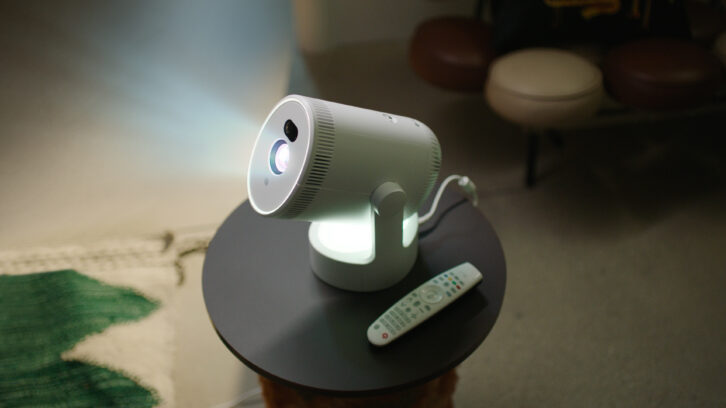
The projector weighs under seven pounds and is easy enough to carry around. While I had it, I took it on a few trips, enjoying it on hotel room ceilings, bedroom walls, fired onto a sheet, my garage door, at my showroom, and, of course, on the Yard Master in my backyard.
The PU700R (and seriously, every time I type that, I can’t help but think “pee-yew!”) is built around Texas Instruments’ 1920- x 1080-pixel DLP chip and uses pixel shifting to put 3840 x 2160 pixels on screen. It is powered by an RGB LED light source that is rated at 30,000 hours in full power mode and has a claimed 1000 ANSI lumens.
There is a single joystick button on top of the projector that offers some limited control such as opening and navigating menus powering the unit on/off, and adjusting volume, but if you lose the included remote, you’ll be in trouble. Inputs, including HDMI 2.2 and USB-A and C, are included behind a small panel on the right side of the unit.
The base of the projector has a built-in LED lamp that I guess is there for mood lighting. You can select from seven different colors, which you cycle through on the remote. Maybe this would be a great thing for a kid’s party, but I found the lighting at any color distracting.
As with many portable beamers, there are no zoom adjustments whatsoever, so you’ll need to manually move the projector forward/back until you hit the right throw distance. For reference, it is a near 1:1 ratio for diagonal image size to throw distance; for a 60-inch image, the projector would sit 63.5 inches away and for a 120-inch image it would sit 128.1 inches back.
The unit includes Auto Screen Adjustment (ASA) that is supposed to “intuitively optimize the screen alignment and focus to remove distortion,” however I found this so finicky as to be unusable (even after a firmware update that was supposed to address issues). Occasionally ASA would work exactly as promised, other times I just could not get it to do anything or it would actually make the picture worse, creating bizarre trapezoid-shaped images.
The auto focus (separate from ASA) usually worked great, but sometimes I could not get it to start. When it worked, it got a sharper, tighter focus than what I could get with the manual focus which didn’t offer as fine of adjustment.
Performance
I’ve got nothing but praise for the Yard Master screen; it did everything it was supposed to do every time I used it. The screen was responsive enough to the remote that I could easily stop it at any position, and the 180-degree off-angle viewing is as good as advertised, allowing me to move off-center as far as anyone would be practically seated and still get an enjoyable image. The only thing I would say is that, while the 1.1 gain material might provide the best uniformity, a bit more gain would be desirable outside, where you’re always competing with some form of ambient lighting.
While I thought the PU700R fulfilled its primary role of delivering an enjoyable image, with nice punchy colors, sometimes getting there took a bit of work.
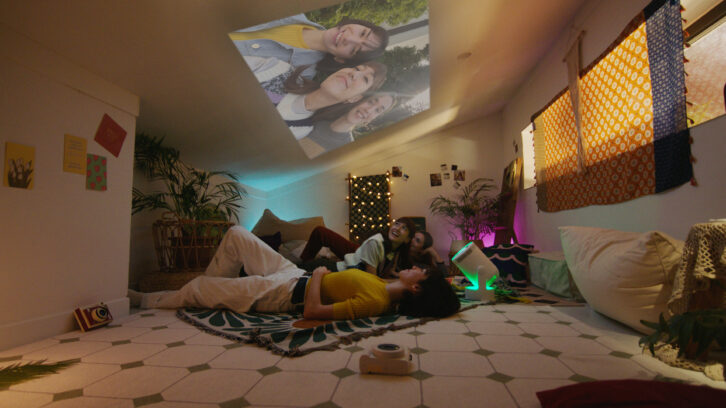
When firing onto a wall/ceiling/whatever that doesn’t have any actual defined borders like a screen, the geometry issues are less of an issue, but when you are firing onto a screen like the Yard Master, if you’re anything like me, you’ll obsess over getting the edges to be as square and level as possible, and this starts with getting the projector height correct. While the LG has that 90-degree adjustable hinge, it is so stiff that it is difficult to fine-tune the position if you are trying to square it to a screen.
Ideally, the ASA would analyze the image and get you close, but in practice, this rarely worked. Fortunately, the LG offers a powerful warp engine with 4-, 9-, and 15-point adjustments that let you bump the corners and edges into place with a massive 0-100 step adjustment at each position.
Even when focused and dialed-in as well as possible, there was a bit of softness at the corners, and the lens couldn’t produce pixel-level detail on the screen, with some noticeable red/blue color fringing around white text. However, this was only really noticeable in test patterns, and never bothered me at a typical seating position.
The projector offers a variety of picture modes, but some like Vivid and Brightest so distort color accuracy they were unusable. The best of the bunch are Filmmaker Mode, Expert (Bright space, daytime), and Expert (Dark space, night). There are also adjustments for motion settings, with “Smooth Movement” completely sorting out the Spears & Munsil motion test patterns, and “Cinematic Movement” being best for 24 fps film watching.
If you’re so inclined, the PU700R can be calibrated with saturation, tint, and luminance adjustments for RGB/CMY, as well as a 2/10/22 point grayscale adjustments.
At 1000 ANSI lumens, the projector isn’t a light cannon, and does its best in dark environments, and when trying to watch at anything below full sunset, it was a struggle to see images on the outdoor screen unless watching something really bright like animation. Black levels are pretty elevated by modern projector standards, looking more a deep grey, and HDR content with low picture levels could look a tad flat and lacking shadow detail, meaning this isn’t a solution for critical viewing in a dedicated theater.
However, the projector certainly delivered images dark enough to be cinematic even in a fully blacked-out theater environment and was definitely “black enough” when watching outside. HDR performance on things like the bio-luminescent world of Pandora from Avatar: Way of Water or the sizzling lightsabers in Disney+ new series Ahsoka also offered plenty of vibrant details.
Streaming 4K content produced images that looked sharp, detailed, and highly entertaining. Close-ups had tons of detail and colors, especially reds and blues, and were punchy and saturated. However, since I live with a true 4K Sony VP-XW6000ES projector, I was aware of the limitations of the LG’s lens and the fine details where the DLP’s 4K pixel shifting lacks, mostly noticeable in slow-moving pans with really fine horizontal or vertical lines where there would be some blurring or line twitter. Keep this in context though; my reference Sony costs eight-times what the LG does, so it should look a lot better. Considering the LG retails for under $1,500 and can easily be carried around from room to room, taken on trips or brought outdoors, it delivers an extremely satisfying image.
My two biggest gripes are with the projector’s webOS and sound.
With Wi-Fi and streaming built-in, the LG is ready to deliver entertainment all on its own. Unfortunately, the library of streaming services available has a lot of holes. While it does have a built-in Web browser and includes popular apps like Disney+, YouTube, Prime Video, Movies Anywhere, Apple TV, Peacock, and Fubo (as well as several fringe services I’d never really heard of), it is missing biggies like Netflix, Paramount+, Max, Hulu, and Vudu. (Per LG, “Netflix will not be added in the future.”) It does support Apple AirPlay 2 and Chromecast; however, even with these services I was unable to get Netflix to play on the unit, even when trying to screen mirror my phone, getting a “We can’t support playing this download through AirPlay” notice on my phone. Of course, you could always connect a laptop or streamer to the HDMI or USB inputs, but that means toting another device around.
The included Magic Remote includes a voice microphone button — and talks about it in the manual — but this never worked for me. Pressing it delivered a “One moment please. Voice Recognition service will be available shortly,” or “This function is not available in the current keyboard language.”
However, the bigger OS issue is that it can often be agonizingly slow to respond to a button press or for an app to open/exit. On several occasions, it was just easier to power-cycle the projector and start over than to wait for something to open. This was mainly an issue when trying to open or navigate the settings menu while something was streaming, and almost felt like the processor on board is just underpowered and overtaxed with everything it is being called on to do.
While it’s true you don’t buy a projector for its audio, in a portable unit this is a pretty important feature, and the onboard 5-watt mono speaker delivered audio that that ranged from borderline unusable to acceptable. While watching at a hotel with the projector positioned on a nightstand between two beds and my wife and I lying next to it on either side, we still couldn’t hear what was being said. Add in the ambient noise of the great outdoors, and you’ll be relying on subtitles a lot. The audio levels seem to be worst on Disney+ and Apple TV and best/loudest on YouTube.
After digging a few levels down into the menu, I found an AI Sound setting that “automatically optimizes sound based on content type” and this made a real improvement in actually hearing the dialog. (Oddly, this isn’t offered as a choice in the far-easier-to-access sound modes.)
Fortunately, you can use HDMI ARC or Bluetooth to pair it with external speakers, though surprisingly not a mini-jack analog or Toslink digital connection. I paired it with a Sonos Move and Era 300 speaker, and this greatly improved the audio experience.
The projector does support Bluetooth Dual Sound Out, letting you connect up to two speakers or sets of headphones, and also has an option for using a Bluetooth speaker along with the internal speaker, either playing together or in a surround sound configuration. However, when pairing with the internal speaker, volume was again restricted to the point that it was essentially useless. And the “surround” setting just seemed to add a bit of delay and seemed more echoey than anything.
In my outdoor install, it needs to be pretty dark before I can get a decent image, and it needs to be night to get something really impressive. The issue with watching outside is that it is almost impossible to get ambient light level anything close to black. Between star light, streetlights, neighbors’ lights, cars driving by, etc., you have to realize that the outdoors is never going to be a reference environment. Also, nothing brings out the critters in your neighborhood like a giant beaming spotlight reflecting light off a 125-inch screen, and having a variety of things flying around you and landing on the screen will likely be an issue. But if you can get past those annoyances, then an outdoor movie event can be a ton of fun!
While the Wireless Yard Master is intended as an outdoor screen, the picture quality and viewing angle of the CineWhite fabric would also make it a perfect candidate for an indoor install where a power retro isn’t possible, and, paired with a portable projector like LG’s PU700R, you have an incredibly potent entertainment solution for just over $3000!
562-483-8198 / ELITESCREENS.COM
Product Specs:
- Internal rechargeable battery, tab-tensioned projection screen designed for outdoor use
- Battery lasts up to 200 cycles on a single charge
- IPX3 rated screen resists water spray less than 60 degrees from vertical
- CineWhite 1.1 gain matte white material with a 180-degree viewing angle and 4-side masking borders with black backing to eliminate light penetration
- Available in 125- and 140-inch diagonal 16×9 aspect
800-243-0000 / LG.COM
Product Specs:
- 4K DLP projector using RGB LED light engine rated at 30,000 hours
- Built-in Wi-Fi (2.4/5GHz) with LG’s webOS
- Supports streaming apps like Disney+, YouTube, Amazon Prime, Movies Anywhere, Apple TV, and Peacock
- Flexible hinge design allows for full 90-degree rotation
- 5-watt mono speaker along with Bluetooth wireless streaming
- Inputs for HDMI/ARC 2.2 and USB Type A and C connections
